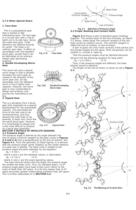
Catalog excerpts

2.7.4 Other Special Gears 1. Face Gear This is a pseudobevel gear that is limited to 900 intersecting axes. The face gear is a circular disc with a ring of teeth cut in its side face; hence the name face gear. Tooth elements are tapered towards its center. The mate is an ordinary spur gear. It offers no advantages over the standard bevel gear, except that it can be fabricated on an ordinary shaper gear generating machine. 2. Double Enveloping Worm Gear This worm set uses a special worm shape in that it partially envelops the worm gear as viewed in the direction of the worm gear axis. Its big advantage over the standard worm is much higher load capacity. However, the worm gear is very complicated to design and produce, and sources for manufacture are few. 3. Hypoid Gear This is a deviation from a bevel gear that originated as a special development for the automobile industry. This permitted the drive to the rear axle to be nonintersecting, and thus allowed the auto body to be lowered, It looks very much like the spiral bevel gear. However, it is complicated to design and is the most difficult to produce on a bevel gear generator. SECTION 3 DETAILS OF INVOLUTE GEARING 3.1 Pressure Angle The pressure angle is defined as the angle between the line-of-action (common tangent to the base circles in Figures 2-3 and 2-4) and a perpendicular to the line-of-centers. See Figure 3-1. From the geometry of these figures, it is obvious that the pressure angle varies (slightly) as the center distance of a gear pair is altered. The base circle is related to the pressure angle and pitch diameter by the equation: db = d cos a (3-1) where d and a are the standard values, or alternately: db = d' cos a' (3-2) where d' and a' are the exact operating values. The basic formula shows that the larger the pressure angle the smaller the base circle. Thus, for standard gears, 14.5º pressure angle gears have base circles much nearer to the roots of teeth than 20º gears. It is for this reason that 14.5º gears encounter greater undercutting problems than 20º gears. This is further elaborated on in SECTION 4.3. 3.2 Proper Meshing And Contact Ratio Figure 3-2 shows a pair of standard gears meshing together. The contact point of the two involutes, as Figure 3-2 shows, slides along The common tangent of the two base circles as rotation occurs. The common tangent is called the line-of-contact, or line-of-action. A pair of gears can only mesh correctly if the pitches and the pressut angles are the same. Pitch comparison can be module m, circular p, base Pb That the pressure angles must be identical becomes obvious trot the following equation for base pitch: Pb = p m COS a (3-3) Thus, if the pressure angles are different, the base pitches cannot b identical. The length of the line-of-action is shown as ab in Figure 3-2. 341
Open the catalog to page 1All Quality Transmission Components catalogs and technical brochures
-
KSUW1.5-R1
1 Pages
-
KKRCPFD10-1000J
1 Pages
-
KSAM1.5-20045
1 Pages
-
KSH2-20R
1 Pages
-
KSS0.5-30C
1 Pages
-
DIAMETRAL PITCH GEAR
34 Pages
-
Q420 Catalog
526 Pages
-
TOOTH THICKNESS
16 Pages
-
SPUR GEAR CALCULATIONS
5 Pages
-
Introduction to Metric Gears
15 Pages
-
DESIGN OF PLASTIC GEARS
15 Pages
-
WORM GEARING
5 Pages
-
BEVEL GEARING
6 Pages
-
HELICAL GEARS
6 Pages
-
INTERNAL GEARS
4 Pages
























